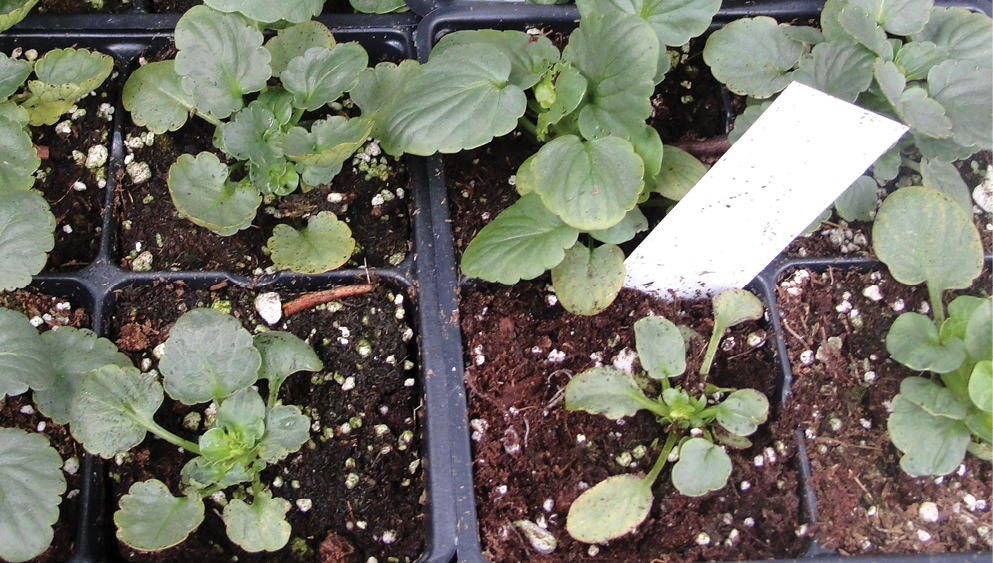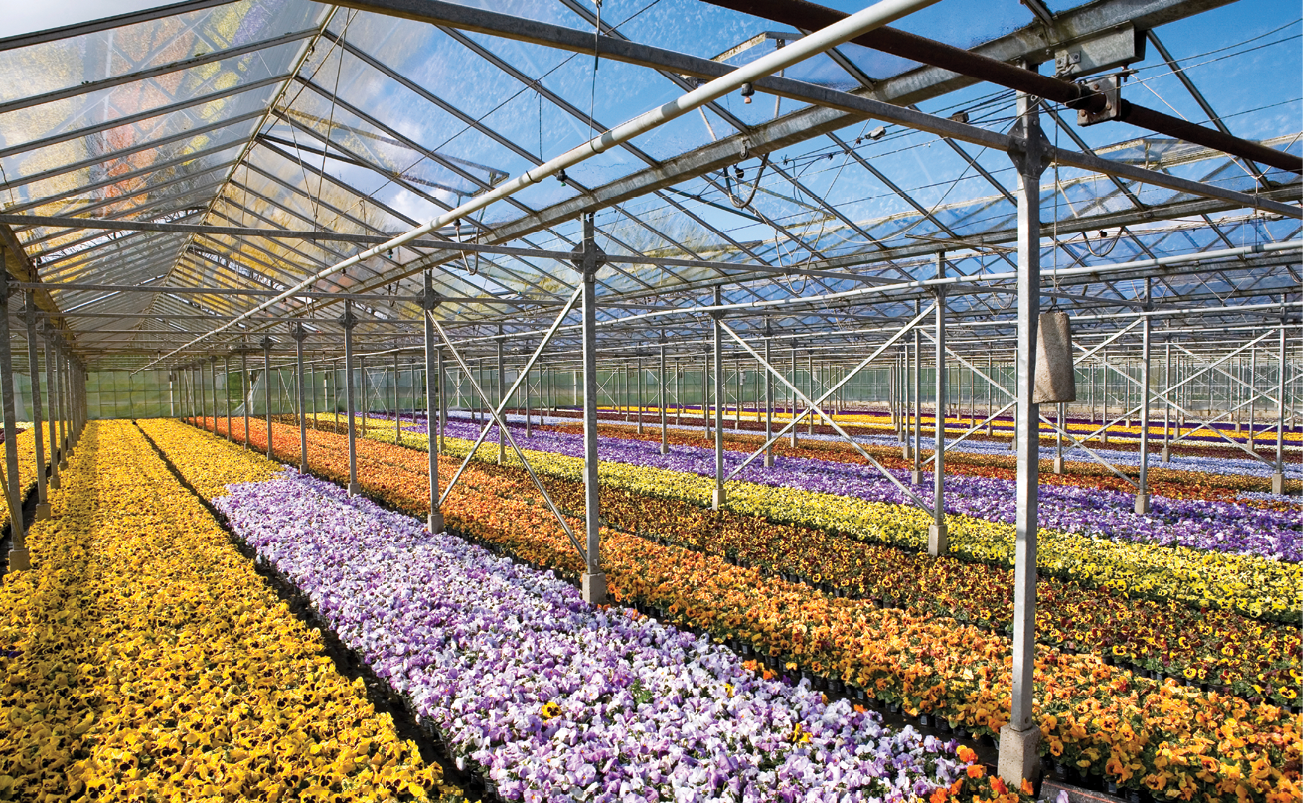
Growing popular, colorful, core seasonal crops — especially rapid ones like pansies — can boost a greenhouse’s bottom line. But whether you start from seeds or plugs in spring or fall, it can be tricky to manage high insect and disease pressure. Knowing what to look for can help prepare growers with preventive and corrective measures that yield a successful, high-quality crop.
BECOME A DISEASE DETECTIVE
“The number of insects and fungal pathogens that pansies are under pressure from — both from a foliar and a root production standpoint — represent big challenges to growers,” says Ron Townsend, technical field manager for turf and ornamentals at Syngenta.
One common disease affecting ornamental plants is Botrytis blight, or gray mold. Caused by the fungus Botrytis cinerea, an aggressive pathogen that can invade living and dead plant tissue, this disease threatens newly propagated material, including young seedlings and unrooted cuttings. Boxed, stored and transported plants are also vulnerable because humidity and ethylene levels contribute to plant stress and susceptibility.
Botrytis thrives in cool, humid environments and is especially problematic in the spring and late fall into winter. Because it can appear virtually overnight, growers must check plants often.
Infections first appear as water-soaked spots on foliage and flowers before gray mold quickly spreads throughout the crop and production area.
Symptoms include small, light brown spots or tiny flecks on flowers; V-shaped, tan-brown lesions on foliage; sunken, discolored cankers on stems; brown, water-soaked flower buds; fuzzy brown or gray spores; and plant wilting.
While all ornamentals are at risk for Botrytis blight, some crops — including pansies — should be checked weekly for signs of disease presence.
GIVE PANSIES THE BEST CHANCE AT SUCCESS
Botrytis and other fungi love moist, humid environments, such as shipping boxes, coolers, crowded spaces and shady locations with poor air circulation. It’s most likely to develop during extended periods of damp, cloudy weather when temperatures hit 62-75°F and humidity levels reach 85% or higher.
“Reducing heat stress, improving sanitation practices, preventively applying fungicides and being vigilant about moisture management are all key factors to prevent and control common pansy diseases,” says Townsend.
“When watering, don’t expose leaf surfaces to excess wetness,” he advises. “Irrigate in the morning and make sure you have good ventilation to dry things out.”
To protect against root diseases like Pythium and Rhizoctonia, Townsend suggests ensuring growers have a moist, but not over-saturated, soil, so seedlings aren’t being attacked by these diseases when they’re most vulnerable.
THE IMPORTANCE OF AGRONOMIC ROTATION PROGRAMS
Because Botrytis is known to develop fungicide resistance, growers should follow a rotation program that includes different modes of action to help reduce the risk. Preventive tactics such as rotating effective fungicides during production will protect the crop and safeguard its quality for sale once it’s transported.
“With fungicides, you want to rotate through fungicide resistance action committee (FRAC) groups. There are multiple fungicide classes — some target certain diseases at certain points in the pathogen’s life cycle,” explains Townsend.
“Rotating through FRAC groups reduces the likelihood of resistance developing. For example, you can rotate from one FRAC group of QoI inhibitor fungicides (QoI) to a demethylation inhibitor (DMI) and then to a contact fungicide, following that sequence again once you get later into production,” adds Townsend. “That’s always a good metric to make sure you’re not developing resistance by spraying the same fungicide over and over.”
When preventing and treating foliar diseases, products such as Postiva™, Mural®, Palladium® and Daconil Ultrex® fungicides make great rotation partners. Root and stem rot diseases can be prevented and treated with fungicides such as Postiva, Mural, Medallion® WDG and Subdue Maxx®.
“Rotation frequency depends on environmental conditions and the pests you’re attacking,” suggests Townsend. “For plants more prone to Pythium and Rhizoctonia, choose a fungicide that’s more active on those diseases on seedlings and apply early in that plant life cycle, and again once that plant becomes mature.”
“Depending on the rate and what you’re applying, you’re looking at a 14- to 21-day rotation between fungicide applications” he says.
“To prevent foliar disease and fungal spots, fungicides should be applied at transplant as a root substrate drench and as a spray a few weeks later,” advises Jamie Gibson, Ph.D., technical lead at Syngenta Flowers. “Insecticides should also be rotated within a pansy program to target pests such as aphids, caterpillars and thrips.”
As the crop matures, Botrytis control is imperative, especially during periods of wet weather as temperatures cool down and Botrytis is more prevalent.

OVERCOME COMMON PANSY PRODUCTION ISSUES
Depending on the season, growers face different production challenges with pansies. Spring production is not as challenging as the fall because there are fewer crop stresses being presented to the grower.
“Most spring pansy growers fill greenhouses in December and January with minimal heating to slowly grow the crop for March and early April sales,” explains Gibson. “A protective root substrate fungicide drench with a foliar systemic insecticide and broad-spectrum foliar fungicide are still required during production but are not as routinely required as the fall.”
For spring pansies, Gibson suggests growers be prepared with a flowering, high-quality crop if weather conditions trigger early spring gardening, so timing of the pansy crops is critical.
“Sometimes, spring comes early in late February and early March, and growers that can respond quickly to the market needs are the most successful. Using the proper genetics with temperature management and lighting are the tools for success,” he adds.
GET AHEAD OF POTENTIAL PROBLEMS
Growers can be proactive in several areas to ensure a bumper crop, beginning with selecting high-performing varieties such as Colossus™, Delta™ Pro and FreeFall™/ FreeFall XL from Syngenta Flowers.
“Colossus pansies grow exceptionally well in summer heat, needing little to no plant growth regulator (PGR), establishing robust plants that flower quickly,” Gibson explains. “The series was bred for heat tolerance and exhibits very large flowers, up to four inches wide, for a powerful retail and landscape display. The Delta Pro series has good heat tolerance for summer production and quick bounce back in climates where fall pansies are often used in the landscape.”
The FreeFall series offers an excellent spreading habit for hanging baskets and combinations and can be used in a variety of harsh and challenging climates. It also delivers a variety of unique colors and patterns with large, stable showy flowers that sell well at retail.
“One major source of pansy crop failure is the improper treatment of plugs upon transplant into the finishing tray or pot,” says Gibson. “To be successful, consider plug status to ensure healthy shoots and roots, fresh growing media with the proper pre-plant charges of limestone, wetting agent and fertilizer, focused irrigation using the proper moisture stages to establish strong roots, fertilization and nutritional monitoring for maintenance of the proper pH and EC, and substrate fungicide drenching to protect root systems.”
Starting pansy crops under some type of structure, such as a greenhouse or shade-house, can prevent intense light levels and undesired solar irradiance upon the crop, he adds.
GET SERIOUS ABOUT PEST AND DISEASE PREVENTION
Managing the primary pests that threaten crop health during fall pansy production, such as aphids, thrips and caterpillars, is key.
“Check the undersides of the leaves where these pests can hide and spray applications of Endeavor® insecticide at 5 oz./100 gal. or Mainspring® GNL insecticide at 4 to 8 fl. oz./100 gal. to control pests for 3 to 4 weeks,” suggests Gibson. Thrips can also injure pansies late in production when blooms are present. Use yellow or blue sticky cards to monitor activity along with general scouting. Avid® 0.15 EC insecticide at 8 fl. oz./100 gal. is also another very effective tool against piercing sucking insects and caterpillars.
Foliar diseases such as Cercospora leaf spot, Anthracnose and Botrytis are common during pansy production, but fungicides can be used in a preventive rotation to protect against them, including Mural fungicide at 6 oz./100 gal., Palladium fungicide at 4 to 6 oz./100 gal. or Daconil Ultrex fungicide at 1.4 lbs./100 gal.
Root and stem rots can also be devastating to a pansy crop. Plants infected by these pathogens are stunted, wilting during the heat of the day and exhibiting signs of nutritional deficiencies that can result in the death of the plant.
“Reducing the chance of infections starts with a clean growing area, utilizing good cultural and sanitation practices and reducing heat stress on the plants. A laboratory confirmation of root and stem diseases is always advised because symptoms are often indistinguishable,” Gibson says.
Rhizoctonia root and stem rot infections often start at the soil line, where you’ll see a dark brown discoloration of the lower stem.
“As the disease progresses, the stem will become girdled, causing the plant to wilt and collapse. Plugs that are planted too deeply are more prone to infection. High temperatures and saturated media conditions can also promote disease,” notes Gibson, who recommends a drench with Medallion WDG at 1 oz./100 gal.
“Stressed and damaged roots are highly susceptible to Pythium root and stem rot infections. It’s best to avoid injuring roots through oversaturated media, heat stress, high salts and EC in planting media,” advises Gibson. Drench applications of Subdue Maxx fungicide 1 fl. oz./100 gal. and Truban® 30 WP fungicide 8 oz. /100 gal. can be rotated on a four-week interval to prevent Pythium infections.
In cooler temperatures, black root rot (Thielaviopsis basicola) can be problematic for growers, causing plants to be stunted with yellow lower foliage and dark lesions on roots.
“Maintaining a lower pH of 5.5 to 5.8 can help suppress this disease,” says Gibson. “Drench rotations using 3336® WP or OHP 6672™ WP at 1 lb./100 gal. and Medallion WDG at 2 oz./100 gal. on a 21-day interval can be used to prevent this disease.”
IMPLEMENT SMART CULTURAL PRACTICES
Townsend says it’s important to develop an integrated pest management (IPM) program that includes avoiding leaf wetness and environments that pathogens and pests thrive in.
“Doing this allows your fungicide and insecticide applications to have longer and better efficacy in the long run because they’re not under as much strain,” he explains.
Here are more expert tips to ensure a successful pansy crop:
- Provide a clean, dry growing environment and examine them frequently for signs of pests or disease.
- Irrigate in the morning.
- Leave enough plant spacing to allow for horizontal airflow.
- Get rid of diseased or damaged plants, dead foliage and flowers quickly to prevent spore production.
- During hot weather, reduce heat stress with lower light levels.
- Prevent calcium or boron deficiencies by fertilizing with plug special (13–2–13) or a Cal-Mag® Plus fertilizer (14–4–14).
- Apply Chrysal Alesco® as a foliar spray to protect ethylene-sensitive crops like pansies during shipping and at retail.
“Chrysal Alesco can be applied as a foliar spray 1 to 2 days before shipping to protect plants from postharvest damage caused by external sources of ethylene and transport stress,” explains Gibson. “It also improves plant quality, resulting in greater sell-through and less shrink at retail.”
Syngenta has developed comprehensive agronomic programs that address the most common disease and insect pests and provide a framework for rotating products and modes of action.
For more information on successful pansy production, visit GreenCastOnline.com/Solutions.
All photos are either the property of Syngenta or are used with permission.
Performance assessments are based upon results or analysis of public information, field observations and/or internal Syngenta evaluations. Trials reflect treatment rates and mixing partners commonly recommended in the marketplace.
© 2024 Syngenta. Important: Always read and follow label instructions. Some products may not be registered for sale or use in all states or counties and/or may have state-specific use requirements. Please check with your local extension service to ensure registration and proper use. Avid®, Colossus™, Daconil Ultrex®, Delta™, Freefall™, GreenCast®, Mainspring®, Medallion®, Mural®, Palladium®, Postiva™, Subdue Maxx® and the Syngenta logo are trademarks of a Syngenta Group Company. All other trademarks are the property of their respective third-party owners.

Explore the HILA Class of 2024 Issue
Check out more from this issue and find your next story to read.
Latest from Greenhouse Management
- Terra Nova Nurseries introduces rust-free and disease-resistant heucherella
- John T. Nickel, founder of Greenleaf Nursery Co., passes away at 89
- Three tours offered at 2025 Farwest Show
- Garden Media Group announces sixth annual Women in Horticulture Week
- Star Roses and Plants announces National Knock Out Rose Day
- The Growth Industry Episode 4: How federal budget cuts are affecting horticulture nonprofits
- The thrips battle plan
- Pennsylvania Horticultural Society shares top gardening trends from 2025 Philadelphia Flower Show





